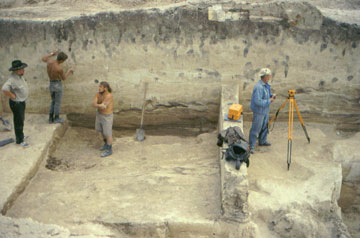|
NEWS NOTES — NEWS
Geoarchaeology
Out of Africa and into Russia
 |
| Researchers excavating at a well-known archaeological site in Russia have found evidence of the earliest-known modern humans in Europe, pushing back the dates of when modern humans arrived in Europe. Photograph is courtesy of John Hoffecker. |
Archaeologists have long thought that when modern humans migrated out of Africa, they traveled first to Western Europe via the Near East and the Balkans. Next, they spread out across the continent, eventually moving into Eastern Europe and Russia. But that may not be the case, according to a new archaeological find that puts modern humans in Russia as early as, if not before, the earliest-known occurrences in Western Europe. Whether that means modern humans took a Russian route out of Africa and into Europe or two separate dispersal routes is unknown. What is known, researchers say, is that the discovery is shaking up human migration models.
About 400 kilometers south of Moscow along the west bank of the Don River lay 21 archaeological sites at varying depths. The sites at Kostenki, as this area is known, have been described and analyzed for more than a century. Remains date from more than 40,000 years ago to the present day, with the only lapse in human occupation found at the peak of the last glacial maximum about 22,000 years ago, says John Hoffecker of the University of Colorado at Boulder. New dates from the oldest layers at Kostenki, however, push back the dates of earliest occupation by several thousand years, to between 45,000 and 42,000 years ago, Hoffecker and colleagues reported Jan. 12 in Science.
Below a 10-centimeter-thick layer of volcanic ash, or tephra, some 3 meters below the surface, Hoffecker and colleagues found a layer of apparently modern human occupation. The team found stone and bone tools, ornaments and a carved ivory figurine in this occupation layer, as well as some bird and mammal remains. They also located a human tooth.
To estimate the age of the oldest layer, the team used dates obtained from the overlying tephra, which is 41,000 to 38,500 years old. The researchers further confirmed those dates by correlating the timing with climatic changes in the Atlantic and paleomagnetic dating. The layer is likely more than 41,000 years old.
To further constrain the settlement dates, the team used optically stimulated luminescence dating — which dates the last time the surface of a rock or artifact was exposed to sunlight — on sediments above and below the tephra. They also calibrated radiocarbon dates, which are broadly consistent with the other dates but tend to underestimate the age of materials in this time range, Hoffecker says. The dates indicate that the oldest layer at Kostenki is significantly older than 40,000 years and possibly as much as 45,000 years old — “perhaps the oldest Upper Paleolithic site in Europe,” he says. It is certainly the earliest-known appearance of modern humans in the Eastern European Plain.
“This find is kind of mind-blowing,” says Daniel Adler of the University of Connecticut. “But there isn’t any controversy; their dates are very solid.” The find not only pushes back when the earliest modern humans arrived in Europe, he says, but it also indicates that modern humans may have migrated to Western Europe via Eastern Europe instead of the other way around: “all of our old [migration] models essentially have to be thrown out the window.”
The “odd” part of the story of modern humans migrating to Russia at an early date is that the climate at Kostenki was “absolutely rotten” at the time, especially to people coming from the temperate climate in Africa, Adler says. Indeed, it would have been very cold and very dry at Kostenki at the time, Hoffecker says. So the reason these early people settled in Russia probably didn’t have anything to do with the weather, Adler says.
Instead, they might have settled the Don Valley a little bit at a time, migrating a few kilometers further with each generation as populations expanded, Adler says. Or, Hoffecker notes, modern humans might have settled this region because Neanderthals — potential competitors for food — were absent at this time. (No traces of Neanderthals have been found in any layer at Kostenki to date.) Additionally, he says, despite the cold, the valley was teeming with plants, trees and animal life, not to mention the natural mineral springs. That people would settle this area is not surprising, he says, as it would have provided them with food, water and material goods.
Still, exactly why Kostenki was settled will probably never be known, Adler says, and the find actually poses more questions than it answers. But the site does suggest that there is much more to be found, especially in regions such as the former Soviet Union that have long been underappreciated by the archaeological community, he says. “Western Europe is the cul-de-sac of archaeology,” he says. “It’s a dead end. Central Asia is where we’re going to find all sorts of new sites over the next few years.”

 Subscribe
Subscribe


